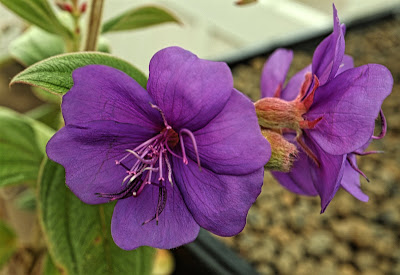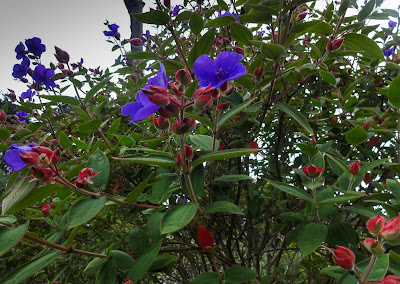Tibouchina urvilleana - Princess flower - Pleroma urvilleanum is found growing in the tropical rain forest. But it also grows in agricultural areas...
Tibouchina urvilleana also called as Princess flower, Glory bush, Lasiandra, Pleroma, Purple glory tree, Lasiandra macrantha, Lasiandra urvilleana, Tibouchina paulistana, Tibouchina urceolaris var. papillosa, Tibouchina urvilleana var. glandulifera and its scientific name Pleroma urvilleanum, is a species of the genus Pleroma. This species was described by Paulo José Fernandes Guimarães and Fabián A. Michelangeli in 2019.
IDENTIFY TIBOUCHINA URVILLEANA - PRINCESS FLOWER
Tibouchina urvilleana is native to Brazil South, Brazil Southeast. It
was introduced into Colombia, Comoros, Costa Rica, Guatemala, Jamaica,
Nicaragua, Venezuela. It is found growing in the tropical rain forest. But it
also grows in agricultural areas, natural/planted forests, ruderal/disturbed
areas, scrub/shrublands and urban areas. It can form thickets in wet habitats,
disturbed areas in forests and along roadsides.
It is an evergreen shrub or small tree which reaching 3–6 meters tall by 2–3 meters wide with reddish, pubescent, somewhat brittle, square branches. The ribbed leaves are oval and new foliage is covered with velvety red hairs. The plants will spread in garden areas by suckers. Lightly prune plants after flowering to control unwanted legginess and spread.
Princess flower blooms in summer through fall from the ends of the branches with rich royal purple five-petaled, 2-3 inch flowers in clusters. The flowers are several but not opening together, very large and showy. In tropical areas, it will bloom sporadically throughout the year. The fruits are egg-shaped, pale brownish; capsules 8-14 mm long, five-celled, with many small round seeds.
TIBOUCHINA URVILLEANA - PRINCESS FLOWER CARE AND CULTURE
Cultural information should only be used as a guide, and should be to be adapted to suit you. Your physical location; where you grow your plants, how much time you have to devote to their care, and many other factors, will need to be taken into account. Only then can you decide on the cultural methods that best suit you and your plants.
Light:
Tibouchina urvilleana prefers full sun but can tolerate partial shade with at least five hours of direct sunlight each day. In a particularly hot area, the plant need ample protection from strong wind and direct afternoon sun. Do not plant them in windy spots. Around buildings, they do best on the east or north side.
Temperature:
Princess flower can grow outdoors in USDA zone 9-11. In zone 8, the plants will typically die to the ground in winter, but will often grow back from the roots in spring. It will tolerate lower temperatures to above freezing although it will slow growth and flowering. The plants are sensitive to frost, however, and containers should be brought indoors to a cool bright room for overwintering as houseplants before first fall frost. When grown indoor, maintain the temperature of above 13 °C.
Humidity:
Pleroma urvilleanum needs very high humidity - at least 70%. It is best to use an air humidifier or spray the plant several times a day. Otherwise, it may not bloom.
Substrate, growing media and repotting:
Tibouchina urvilleana is best grown in moist, acidic, organically rich, fertile, well-drained soils. They don't like alkaline soils (those soils with a pH of 7 or above), but flourish in slightly acidic soils with a pH of around 5.5 to 6.5. If the soil is not acidic enough the leaf burns at the edges, turns brown and eventually the leaves dies. If that happens, correct the soil acidity by adding sulphur on the ground, around the roots, or use an acidifying fertiliser.
The plants can also be grown in containers with the potting mix of peat-based soil and perlite, sand, or vermiculite. Repot is best done in spring. Note the size of the the plant that you want to repot, and size your container no more than 1-2 inches larger than the one your plant is currently residing in.
Mulching:
Use mulches to control weeds, conserve moisture, and provide more uniform soil temperatures. Mulches can be made of sawdust, bark dust, peat moss, straw, or other organic materials. If these materials are incorporated into the soil after serving as a mulch, add some nitrogen to assist in decomposition of the woody materials.
Watering:
Princess flower is somewhat tolerant of drought but does best when regularly watered. Water the plant several times per week during bouts of dry, hot weather. Water the plant once per week during winters that are moist. Do not keep the planting area flooded with water, as the plant can develop root rot.
Fertilizer:
Feed with a balanced fertilizer like a 15-15-15 or lower at regular intervals throughout its active growing season. Apply around the entire drip line, not allowing the fertilizer to touch the main trunk, or it will get burned. Discontinue or reduce frequency during the winter, especially if plants are grown below 16 °C.
Pruning:
Pleroma urvilleanum do need pruning to control the size and shape, otherwise they will grow into a fairly large tree. Prune the plant after they finish flowering, usually in early spring so foliage can grow back in time for the blooming season in summer. Do not prune in late fall or winter, as the plant will be more susceptible to damage from frosts or freezes. Cut plants damaged by frosts or freezes down to the ground in spring, as new growth might grow back from the roots. Delaying the pruning means you throw the whole flowering season out of kilter and this will result in spasmodic flowering. Pinching off new growth will encourage branch formation and make the shrub fuller.
Pests and diseases:
Princess flower have trouble with edema, which happens when the plants are moved inside before frost. This appears as a whitish outgrowth on the tops of the leaves. In severely affected plants it can damage the leaves badly. Aphids and to some extent spider mites can be troubling insects. Few problems with foliar and root diseases.
Propagation:
Tibouchina urvilleana can be propagated by rooting softwood cuttings: Cut 4-inch lengths of soft green stem, making the cut just below a leaf node. Remove the leaves from the bottom half of the stem, then dip the ends into rooting hormone. Plant the cutting into a container filled with a seed-starter mix, then cover the container with a large plastic bag or plastic dome. Place the cutting in a bright area out of direct sunlight, with temperatures between 18-24 °C. Open the bag or remove the dome daily to mist the soil and cuttings. After 10 to 12 weeks, the cutting should be sufficiently rooted so that it can be potted up or planted in an outdoor garden location.
BUY TIBOUCHINA URVILLEANA - PRINCESS FLOWER AND RELATED PRODUCTS
BUY ANOTHERS SPECIES AND VARIETIES OF TIBOUCHINA GENUS HERE!

















COMMENTS